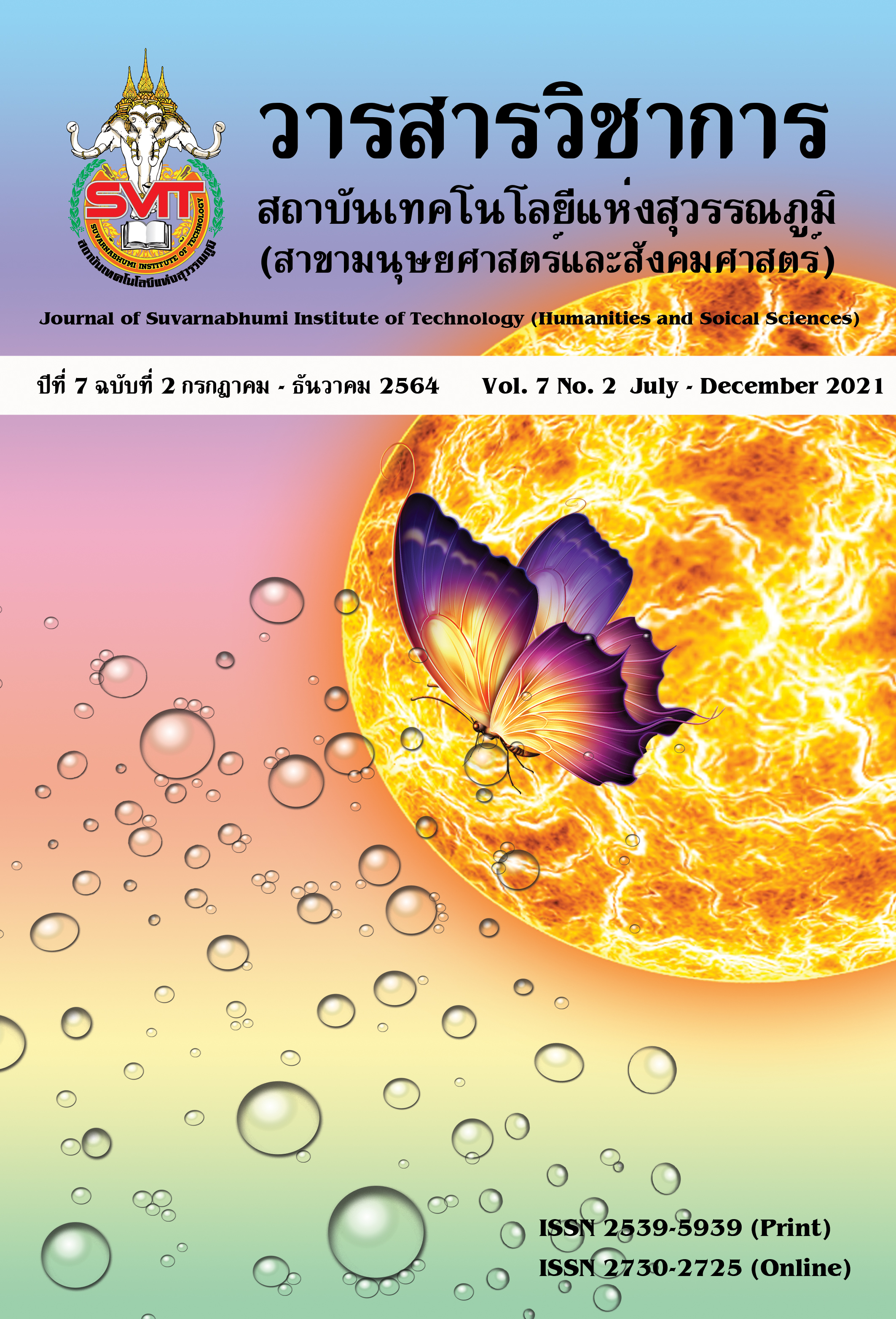HUMAN CAPITAL DEVELOPMENT OF THAI PRIVATE UNIVERSITIES LECTURER IN BANGKOK METROPOLITAN REGION
Keywords:
Human Capital, Achievement, Lecturer at Private UniversitiesAbstract
This research aims to study human capital development that affects the achievement of a professor of Thai teachers in Bangkok and perimeter, and to study the development of human capital, which affects the achievement of a professor of Thai-private universities in Bangkok and perimeter. Use a query to store information from a sample group that is currently running in private universities in Bangkok and perimeter. The total number of 385 is then analyzed for recession-related equations and results in the analysis of human capital development that affects the achievement of the professor of the University of Thailand in Bangkok and perimeter. Use the deep interview by 9 experts and build up the human capital development guidelines that affect the achievement of the professor of the University of Thailand in Bangkok and perimeter research results. Found that human capital development is a way to develop human capital, need to develop human capital and internal factors that affect the achievement of the professor of Thai-private universities in Bangkok. The city and perimeter are significantly statistical at a level .05 and a way of developing human capital to affect the achievement of the professor of the University of Thailand in Bangkok and perimeter. 3-sided divided into 1) need for human capital development 2) internal factors and 3) human capital development methods
References
โชคชัย สุเวชวัฒนกูล, และกนกกานต์ แก้วนุช. (2555). ทางเลือก-ทางรอดจากวิกฤติเศรษฐกิจของกิจกรรมทุนมนุษย์ในอุตสาหกรรมการท่องเที่ยวและบริการตามหลักปรัชญาเศรษฐกิจพอเพียง: กิจกรรมการบริหารและการพัฒนาทุนมนุษย์. กรุงเทพฯ: สถาบันบัณฑิตพัฒนบริหารศาสตร์.
ทิศทางการศึกษาของไทยในบริบทประชาคมอาเซียน. (2558). สืบค้น 15 มกราคม 2559, จาก http:// www.kus. kps.ku.ac.th /satit/asean/
แผนพัฒนาการศึกษาระดับอุดมศึกษา ฉบับที่ 12 (พ.ศ.2560-2564). สืบค้น 21 กันยายน 2561, จาก http://www.mua.go.th/.
พิมพ์ลักษณ์ อยู่วัฒนา. (2557). แนวทางการพัฒนาศักยภาพบุคลากรสายสนับสนุนเครือข่ายบริการสาธารณสุขจังหวัดสมุทรสงคราม (รายงานการวิจัย). สมุทรสงคราม: โรงพยาบาลอัมพวา.
มนัญชยา ยอแซฟ, และพิศมัย จารุจิตติพันธ์. (2562). ปัจจัยและนโยบายด้านทรัพยากรบุคคลที่ส่งผลต่อคุณภาพชีวิตการทำงานของบุคลากรในสถาบันอุดมศึกษาเอกชน. วารสารสังคมศาสตร์มหาวิทยาลัย ศรีนครินทรวิโรฒ, 21(21), 194-205.
วรนันท์ บุนนาค. (2553). การบริหารเชิงกลยุทธ์ที่เหมาะสม สำหรับการเป็นมหาวิทยาลัยในกำกับของรัฐ:กรณีศึกษามหาวิทยาลัยขอนแก่น. ขอนแก่น: บัณฑิตวิทยาลัยมหาวิทยาลัยภาคตะวันออกเฉียงเหนือ.
ศุภานัน พุฒตาล. (2560). ปัจจัยที่มีแนวโน้มการลาออกของพนักงานมหาวิทยาลัย สายวิชาการ มหาวิทยาลัยเทคโนโลยีราชมงคลธัญบุรี (รายงานผลการวิจัย). ปทุมธานี: มหาวิทยาลัยเทคโนโลยีราชมงคลธัญบุรี.
สมาคมสถาบันอุดมศึกษาเอกชนแห่งประเทศไทย. (2561). ประวัติความเป็นมาสมาคมสถาบันอุดมศึกษาเอกชนแห่งประเทศไทย. สืบค้น 21 กันยายน 2561, จาก https://www.apheit.org/2012-06-23-09-30-55
สุภางค์ จันทวานิช. (2554). การวิเคราะห์ข้อมูลในการวิจัยเชิงคุณภาพ. กรุงเทพฯ: สำนักพิมพ์แห่งจุฬาลงกรณ์มหาวิทยาลัย.
เอกอนงค์ ศรีสำอางค์. (2559). การธำรงรักษาอาจารย์ในสถาบันอุดมศึกษาไทย: กรณีศึกษามหาวิทยาลัยในเขตกรุงเทพมหานคร. วารสารวิชาการบัณฑิตวิทยาลัยสวนดุสิต, 12(3), 101-113.
Conrad, C.F., & Blackburn, R.T. (1985). Program Quality in Higher Education. In Smart, J.C.(ed). Higher Education: Handbook of Theory and Research, 1. New York: Agathorn.
Livingstone Makondo. (2014). Academic Advising in Universities: Concept Paper. Kamla-Raj 2014, ACADEMIC ADVISING, J Sociology Soc Anth, 5(2).
Pipe, T. B., Conner, K., Dansky, K., Schraeder, C., & Caruso, E. (2005). Perceived involvement in decision-making as a predictor of decision satisfaction in older adults. Journal of nursing research, 6(4), 1-12.
Sylvia N. Naris & Wilfred I. Ukpere. (2012). Evaluation of human resource development and training at a higher educational institution in Namibia. African Journal of Business Management, 6, 49.
Ulrich, D., & Dulebohn, J. H. (2015). Are we there yet? What's next for HR? Human Resource Management Review, 25(2). 188-204.
Yamane. (1967). Taro Statistic: An Introductory Analysis. New York: Harper & row.
Downloads
Published
Issue
Section
License
บทความที่ได้รับการตีพิมพ์เป็นลิขสิทธิ์ของวารสารวิชาการ สถาบันเทคโนโลยีแห่งสุวรรณภูมิ
ข้อความที่ปรากฏในบทความแต่ละเรื่องในวารสารวิชาการเล่มนี้เป็นความคิดเห็นส่วนตัวของผู้เขียนแต่ละท่านไม่เกี่ยวข้องกับสถาบันเทคโนโลยีแห่งสุวรรณภูมิ และคณาจารย์ท่านอื่นๆในสถาบันฯ แต่อย่างใด ความรับผิดชอบองค์ประกอบทั้งหมดของบทความแต่ละเรื่องเป็นของผู้เขียนแต่ละท่าน หากมีความผิดพลาดใดๆ ผู้เขียนแต่ละท่านจะรับผิดชอบบทความของตนเองแต่ผู้เดียว





